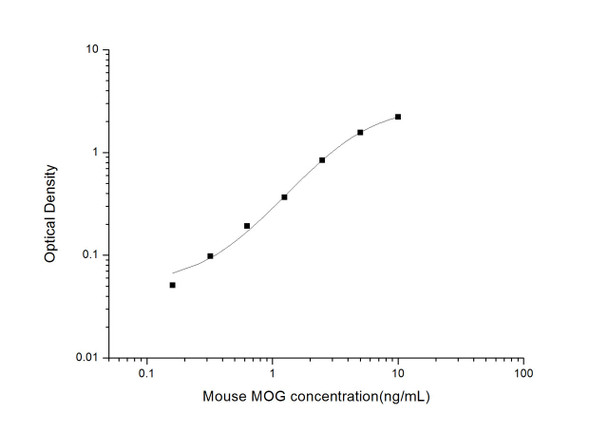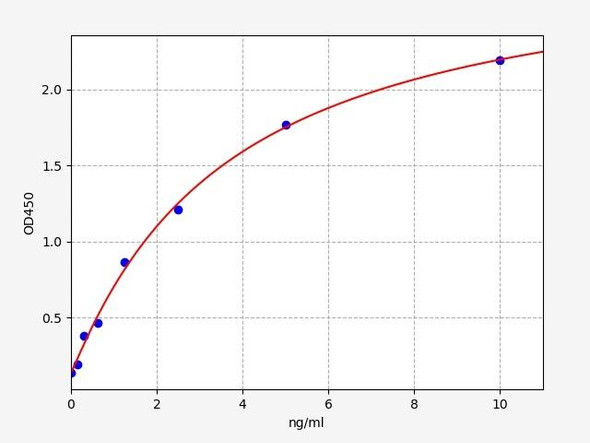Mouse MOG (Myelin Oligodendrocyte Glycoprotein) ELISA Kit (MOES01743)
- SKU:
- MOES01743
- Product Type:
- ELISA Kit
- Size:
- 96 Assays
- Uniprot:
- Q61885
- Sensitivity:
- 0.09ng/mL
- Range:
- 0.16-10ng/mL
- ELISA Type:
- Sandwich
- Synonyms:
- MOGIG2, NRCLP7
- Reactivity:
- Mouse
- Sample Type:
- Serum, plasma and other biological fluids
- Research Area:
- Cell Biology
Description
Mouse MOG (Myelin Oligodendrocyte Glycoprotein) ELISA Kit
The Mouse MOG (Myelin Oligodendrocyte Glycoprotein) ELISA Kit is a powerful tool for the quantitative measurement of MOG levels in mouse serum, plasma, and tissue lysates. With its superior sensitivity and specificity, this kit delivers accurate and reproducible results, making it suitable for various research applications.MOG is a key protein found in the myelin sheath of nerve fibers, essential for proper nerve function and signaling.
Dysregulation of MOG has been implicated in autoimmune diseases such as multiple sclerosis, making it a valuable biomarker for studying these conditions and developing potential treatments.This ELISA kit from Assay Genie provides researchers with a reliable and efficient method for measuring MOG levels, offering insights into neurological diseases and potential therapeutic strategies.
| Assay type: | Sandwich |
| Format: | 96T |
| Assay time: | 4.5h |
| Reactivity: | Mouse |
| Detection Method: | Colormetric |
| Detection Range: | 0.16-10 ng/mL |
| Sensitivity: | 0.10 ng/mL |
| Sample Volume Required Per Well: | 100µL |
| Sample Type: | Serum, plasma and other biological fluids |
| Specificity: | This kit recognizes Mouse MOG in samples. No significant cross-reactivity or interference between Mouse MOG and analogues was observed. |
This ELISA kit uses Sandwich-ELISA as the method. The micro ELISA plate provided in this kit has been pre-coated with an antibody specific to Mouse MOG. Standards or samples are added to the appropriate micro ELISA plate wells and combined with the specific antibody. Then a biotinylated detection antibody specific for Mouse MOG and Avidin-Horseradish Peroxidase (HRP) conjugate are added to each micro plate well successively and incubated. Free components are washed away. The substrate solution is added to each well. Only those wells that contain Mouse MOG, biotinylated detection antibody and Avidin-HRP conjugate will appear blue in color. The enzyme-substrate reaction is terminated by adding Stop Solution and the color turns yellow. The optical density (OD) is measured spectrophotometrically at a wavelength of 450 nm ± 2 nm. The OD value is proportional to the concentration of Mouse MOG. The concentration of Mouse MOG in samples can be calculated by comparing the OD of the samples to the standard curve.
| UniProt Protein Function: | MOG: Mediates homophilic cell-cell adhesion. Minor component of the myelin sheath. May be involved in completion and/or maintenance of the myelin sheath and in cell- cell communication. Defects in MOG are the cause of narcolepsy type 7 (NRCLP7). Neurological disabling sleep disorder, characterized by excessive daytime sleepiness, sleep fragmentation, symptoms of abnormal rapid-eye-movement (REM) sleep, cataplexy, hypnagogic hallucinations, and sleep paralysis. Cataplexy is a sudden loss of muscle tone triggered by emotions, which is the most valuable clinical feature used to diagnose narcolepsy. Human narcolepsy is primarily a sporadically occurring disorder but familial clustering has been observed. Belongs to the immunoglobulin superfamily. BTN/MOG family. 10 isoforms of the human protein are produced by alternative splicing. |
| UniProt Protein Details: | Protein type:Membrane protein, multi-pass; Membrane protein, integral Cellular Component: cell surface; membrane; integral to membrane; myelin sheath; lipid raft Biological Process: positive regulation of MyD88-dependent toll-like receptor signaling pathway; cell adhesion |
| UniProt Code: | Q61885 |
| NCBI GenInfo Identifier: | 113199771 |
| NCBI Gene ID: | 17441 |
| NCBI Accession: | NP_034944. 2 |
| UniProt Secondary Accession: | Q61885,P70364, Q62003, |
| UniProt Related Accession: | Q61885 |
| Molecular Weight: | 28,271 Da |
| NCBI Full Name: | myelin-oligodendrocyte glycoprotein |
| NCBI Synonym Full Names: | myelin oligodendrocyte glycoprotein |
| NCBI Official Symbol: | Mog |
| NCBI Official Synonym Symbols: | B230317G11Rik |
| NCBI Protein Information: | myelin-oligodendrocyte glycoprotein |
| UniProt Protein Name: | Myelin-oligodendrocyte glycoprotein |
| Protein Family: | Molybdopterin adenylyltransferase |
| UniProt Gene Name: | Mog |
| UniProt Entry Name: | MOG_MOUSE |
As the OD values of the standard curve may vary according to the conditions of the actual assay performance (e. g. operator, pipetting technique, washing technique or temperature effects), the operator should establish a standard curve for each test. Typical standard curve and data is provided below for reference only.
| Concentration (ng/mL) | O.D | Average | Corrected |
| 10 | 2.299 2.307 | 2.303 | 2.212 |
| 5 | 1.641 1.683 | 1.662 | 1.571 |
| 2.5 | 0.939 0.925 | 0.932 | 0.841 |
| 1.25 | 0.441 0.475 | 0.458 | 0.367 |
| 0.63 | 0.287 0.281 | 0.284 | 0.193 |
| 0.32 | 0.193 0.185 | 0.189 | 0.098 |
| 0.16 | 0.134 0.15 | 0.142 | 0.051 |
| 0 | 0.087 0.095 | 0.091 | -- |
Precision
Intra-assay Precision (Precision within an assay): 3 samples with low, mid range and high level Mouse MOG were tested 20 times on one plate, respectively.
Inter-assay Precision (Precision between assays): 3 samples with low, mid range and high level Mouse MOG were tested on 3 different plates, 20 replicates in each plate.
| Intra-assay Precision | Inter-assay Precision | |||||
| Sample | 1 | 2 | 3 | 1 | 2 | 3 |
| n | 20 | 20 | 20 | 20 | 20 | 20 |
| Mean (ng/mL) | 0.46 | 1.57 | 4.99 | 0.50 | 1.69 | 5.45 |
| Standard deviation | 0.03 | 0.06 | 0.20 | 0.03 | 0.10 | 0.24 |
| C V (%) | 6.52 | 3.82 | 4.01 | 6.00 | 5.92 | 4.40 |
Recovery
The recovery of Mouse MOG spiked at three different levels in samples throughout the range of the assay was evaluated in various matrices.
| Sample Type | Range (%) | Average Recovery (%) |
| Serum (n=5) | 95-107 | 101 |
| EDTA plasma (n=5) | 88-100 | 95 |
| Cell culture media (n=5) | 87-101 | 94 |
Linearity
Samples were spiked with high concentrations of Mouse MOG and diluted with Reference Standard & Sample Diluent to produce samples with values within the range of the assay.
| Serum (n=5) | EDTA plasma (n=5) | Cell culture media (n=5) | ||
| 1:2 | Range (%) | 96-113 | 92-105 | 91-105 |
| Average (%) | 104 | 97 | 97 | |
| 1:4 | Range (%) | 86-101 | 84-98 | 83-94 |
| Average (%) | 93 | 90 | 88 | |
| 1:8 | Range (%) | 89-100 | 83-96 | 86-96 |
| Average (%) | 95 | 88 | 91 | |
| 1:16 | Range (%) | 93-104 | 86-97 | 87-98 |
| Average (%) | 99 | 91 | 93 |
An unopened kit can be stored at 4°C for 1 month. If the kit is not used within 1 month, store the items separately according to the following conditions once the kit is received.
| Item | Specifications | Storage |
| Micro ELISA Plate(Dismountable) | 8 wells ×12 strips | -20°C, 6 months |
| Reference Standard | 2 vials | |
| Concentrated Biotinylated Detection Ab (100×) | 1 vial, 120 µL | |
| Concentrated HRP Conjugate (100×) | 1 vial, 120 µL | -20°C(shading light), 6 months |
| Reference Standard & Sample Diluent | 1 vial, 20 mL | 4°C, 6 months |
| Biotinylated Detection Ab Diluent | 1 vial, 14 mL | |
| HRP Conjugate Diluent | 1 vial, 14 mL | |
| Concentrated Wash Buffer (25×) | 1 vial, 30 mL | |
| Substrate Reagent | 1 vial, 10 mL | 4°C(shading light) |
| Stop Solution | 1 vial, 10 mL | 4°C |
| Plate Sealer | 5 pieces | |
| Product Description | 1 copy | |
| Certificate of Analysis | 1 copy |
- Set standard, test sample and control (zero) wells on the pre-coated plate and record theirpositions. It is recommended to measure each standard and sample in duplicate. Note: addall solutions to the bottom of the plate wells while avoiding contact with the well walls. Ensuresolutions do not foam when adding to the wells.
- Aliquot 100µl of standard solutions into the standard wells.
- Add 100µl of Sample / Standard dilution buffer into the control (zero) well.
- Add 100µl of properly diluted sample (serum, plasma, tissue homogenates and otherbiological fluids) into test sample wells.
- Cover the plate with the sealer provided in the kit and incubate for 90 min at 37°C.
- Aspirate the liquid from each well, do not wash. Immediately add 100µL of BiotinylatedDetection Ab working solution to each well. Cover the plate with a plate seal and gently mix. Incubate for 1 hour at 37°C.
- Aspirate or decant the solution from the plate and add 350µL of wash buffer to each welland incubate for 1-2 minutes at room temperature. Aspirate the solution from each well andclap the plate on absorbent filter paper to dry. Repeat this process 3 times. Note: a microplatewasher can be used in this step and other wash steps.
- Add 100µL of HRP Conjugate working solution to each well. Cover with a plate seal andincubate for 30 min at 37°C.
- Aspirate or decant the solution from each well. Repeat the wash process for five times asconducted in step 7.
- Add 90µL of Substrate Reagent to each well. Cover with a new plate seal and incubate forapproximately 15 min at 37°C. Protect the plate from light. Note: the reaction time can beshortened or extended according to the actual color change, but not by more than 30min.
- Add 50 µL of Stop Solution to each well. Note: Adding the stop solution should be done inthe same order as the substrate solution.
- Determine the optical density (OD value) of each well immediately with a microplate readerset at 450 nm.








